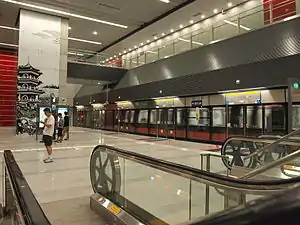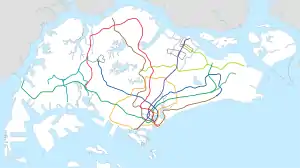Haw Par Villa MRT station
Haw Par Villa MRT station is an underground Mass Rapid Transit (MRT) station on the Circle line (CCL), located within Queenstown planning area, Singapore, located underneath West Coast Highway and Pasir Panjang Road. The station takes its name from the nearby Haw Par Villa, a tourist attraction. It is also close to the Pasir Panjang Wholesale Centre.
CC25
Haw Par Villa 虎豹别墅 ஹா பர் வில்லா Haw Par Villa | |||||||||||
|---|---|---|---|---|---|---|---|---|---|---|---|
| Mass Rapid Transit (MRT) station | |||||||||||
 Platform level of Haw Par Villa MRT station. | |||||||||||
| Location | 270 Pasir Panjang Road Singapore 117396 | ||||||||||
| Coordinates | 1°16′57″N 103°46′55″E | ||||||||||
| Operated by | SMRT Trains Ltd (SMRT Corporation) | ||||||||||
| Line(s) | |||||||||||
| Platforms | 2 (1 island platform) | ||||||||||
| Tracks | 2 | ||||||||||
| Connections | Bus, Taxi | ||||||||||
| Construction | |||||||||||
| Structure type | Underground | ||||||||||
| Platform levels | 1 | ||||||||||
| Disabled access | Yes | ||||||||||
| History | |||||||||||
| Opened | 8 October 2011 | ||||||||||
| Electrified | Yes | ||||||||||
| Previous names | West Coast[1][2] | ||||||||||
| Services | |||||||||||
| |||||||||||
| Location | |||||||||||
 Har Par Villa Har Par Villa station in Singapore | |||||||||||
Currently, a "West Coast Extension" of the future Jurong Region line is being considered. If built, Haw Par Villa station will become an interchange with this extension and serve as its terminus.
History


When the Circle line was initially planned, this station had been planned to open only when the surroundings is more developed and was named West Coast. It was only announced to be opened on 25 January 2008 with the rest of Stage 5 to attract visitors into the Haw Par Villa and subsequently renamed the station to "Haw Par Villa".[3]
West Coast Extension (Jurong Region line)
On 25 August 2015, Lui Tuck Yew at Clementi station announced that there will be a possible West Coast Extension from the Jurong Region line. It said that the West Coast Extension would end at this station, and it would most likely be built in the 2030s.[4][5][6]
Art in Transit
The artwork featured in this station under the Art in Transit programme is Eroclamation by Tan Wee Lit, located on the lift shaft in the station. Inspired by traditional papercuts, the black-and-white artwork shows images of traditionally Chinese elements (such as a pagoda, archway and peonies) with pictures of heavy machinery (tractors, cranes, etc.) hidden in them. The former is a reference to the Chinese-themed attraction which this station is named after, and the latter is a commentary about how much the western side of Singapore is reclaimed land.[7] Keen eyes will also spot the tiger hiding among the peonies, a reference to the name "Tiger Balm Gardens".[8][9]
References
- "CIRCLE LINE, DOWNTOWN LINE 1 AND 2 STATION NAMES FINALISED". www.lta.gov.sg. 16 June 2009. Archived from the original on 22 February 2013.
- "Annex 1: Final Station Names" (PDF). www.lta.gov.sg. Archived from the original (PDF) on 22 March 2013.
- "SPEECH BY MR RAYMOND LIM,MINISTER FOR TRANSPORT, AT THE VISIT TO KIM CHUAN DEPOT, 25 JANUARY 2008, 9.00 am". Singapore Government Media Release. 25 January 2008.
- "More MRT Stations to be Upgraded and Possible Extension of Jurong Region Line". Land Transport Authority. 25 August 2015. Archived from the original on 5 October 2017. Retrieved 5 October 2017.
- "Studies for West Coast extension ongoing". The Straits Times. 24 July 2019. Archived from the original on 24 July 2019. Retrieved 24 July 2019.
- "Jurong line may be extended to link with Circle Line". todayonline.com. 25 August 2015. Archived from the original on 5 October 2017. Retrieved 5 October 2017.
- Martin, Mayo. "Circle Line Art! The final destination(s)! A sneak peek!". For Art's Sake!. TODAYonline Blogs. Archived from the original on 27 December 2011. Retrieved 12 October 2011.
- Massot, Gilles (7 April 2020). "Getting Around - Public Transport - A Better Public Transport Experience - Art in Transit". LTA. Archived from the original on 21 April 2020. Retrieved 21 April 2020.
- "Circle Line Art" (PDF). www.lta.gov.sg. Archived from the original (PDF) on 11 February 2017.